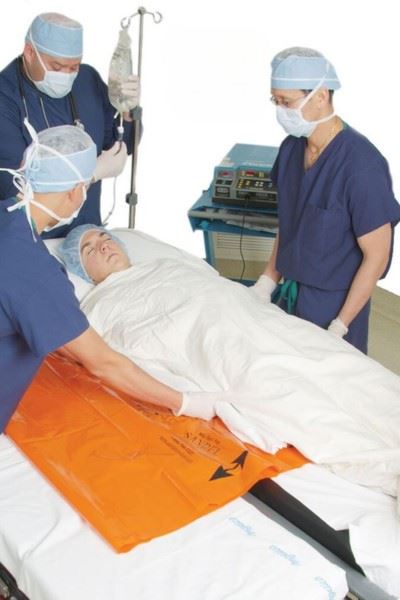-
Home
-
How to Use a Sheet to Transfer Patients
How to Use a Sheet to Transfer Patients
November 7, 2023
 In any hospital setting, the proper handling of patients is essential to their comfort and safety. Proper techniques and equipment are required for safe patient handling, whether you’re repositioning the patient in bed or transferring them from one surface to another. One such tool is the patient transfer sheet, which is commonly used to aid in repositioning and moving patients. In this article, we will discuss the proper use of transfer sheets to ensure the safety of both the caregiver and the patient during the transfer process.
In any hospital setting, the proper handling of patients is essential to their comfort and safety. Proper techniques and equipment are required for safe patient handling, whether you’re repositioning the patient in bed or transferring them from one surface to another. One such tool is the patient transfer sheet, which is commonly used to aid in repositioning and moving patients. In this article, we will discuss the proper use of transfer sheets to ensure the safety of both the caregiver and the patient during the transfer process.
What are Transfer Sheets?
Transfer sheets are simple devices usually made of low-friction material with handles or straps. These sheets are used with other transfer aids—such as rollboards or shifters—to assist with moving, turning, or repositioning patients. While transfer sheets are often used in emergency situations to move patients across surfaces, they also require the most pull force of any transfer aid and require multiple staff members to assist.
Benefits of Transfer Sheets
Though they are only used on their own during emergencies, transfer sheets can provide additional support when using another transfer aid. They also add another measure of infection control when placed over another device, and they are often disposable to reduce cross-contamination risk.
Transfer sheets are also light, compact, and portable, making them easy to store and transport. This easy accessibility is especially beneficial during emergency situations, but it is also important during everyday transfers to maximize efficiency and patient comfort.
How to Safely Use a Transfer Sheet
To move or reposition a patient using a transfer sheet, you should first roll the patient to one side and place the sheet beneath them before rolling them back to a supine position on top of the sheet. It is important to use a transfer sheet with extended handles or straps, as this can help minimize the amount of stretch or pull force required to complete a transfer. Additionally, ensuring ample staff are available to assist is a key factor in reducing injuries and maintaining patient comfort.
Transfer Sheet Recommendations
There are many different types of transfer sheets available depending on your facility’s needs. It is important to use each sheet below in accordance with your facility’s safe patient handling protocol. As previously stated, transfer sheets can be used on their own in emergencies but are recommended for use with other transfer devices.
- AliMed® No-Lift TURNER™ and BOOSTER™: No-Lift repositioning aids are designed with friction-reducing materials for easy sliding, allowing staff to easily perform in-bed repositioning without straining or lifting. The TURNER assists in turning patients from one side to another and requires only one staff to reposition once it’s in place. The BOOSTER helps slide patients up and down and requires at least two staff members to assist.
- MegaMover® Portable Transfer Units: Compact, portable units are super lightweight and convenient for use anywhere—especially in emergency situations. These devices are made of durable, fluid-resistant material and feature ample handles on each side.
- Z-Slider® Patient Transfer and Repositioning Sheets: Disposable, compact sheets come with a wall-mountable dispenser for quick access during emergencies.
- AliMed® Bariatric Turner: With a 400-lb. weight capacity and 12 handles for easy lifting, the Bariatric Turner allows up to six staff members to safely turn, reposition, or lift bariatric patients.
Transfer sheets are effective when turning or repositioning patients and when lifting or transfering patients—either on their own in emergency situations or with the use of other transfer devices. These sheets provide a friction-reducing surface for easier patient handling and can provide added infection control. By utilizing proper techniques and equipment, staff members can facilitate safe, efficient patient transfers that pose minimal injury risk to both staff and patients.
Want more information? Visit AliMed’s Safe Patient Handling Resource Hub to explore a multitude of educational resources, including a new guidebook, printable staff training posters, podcasts, infographics, videos, and more.